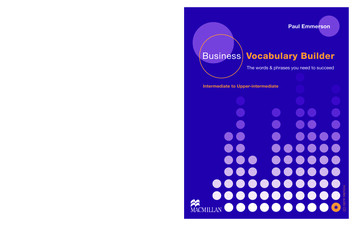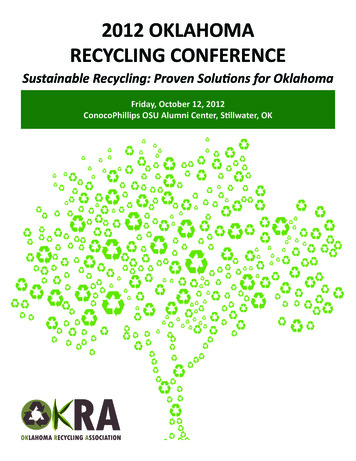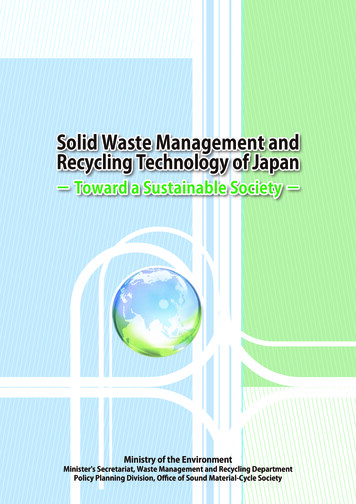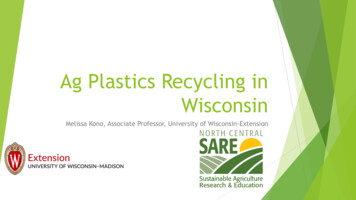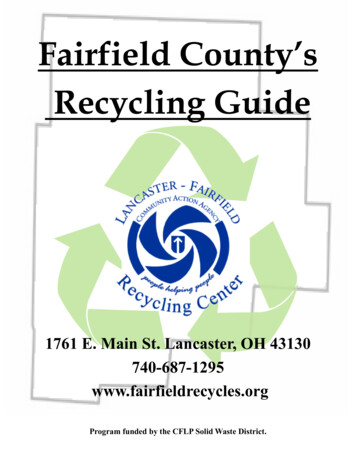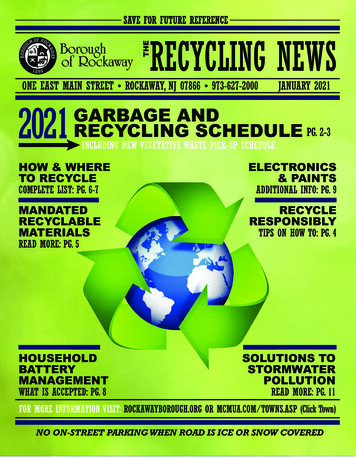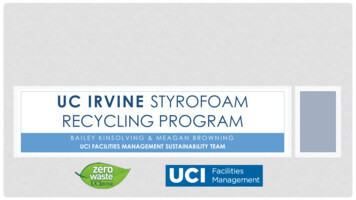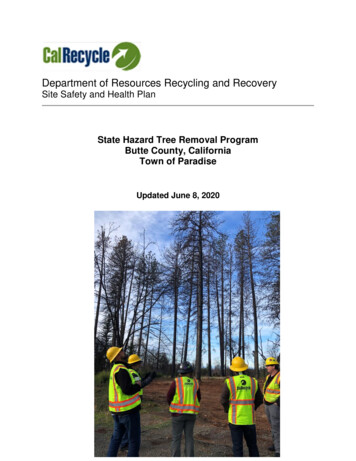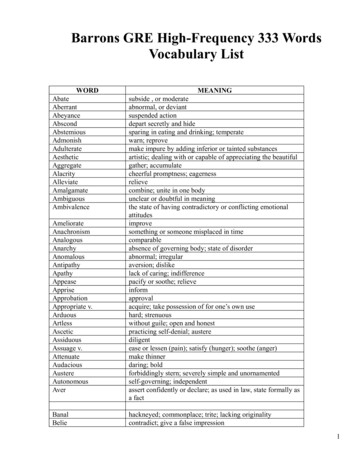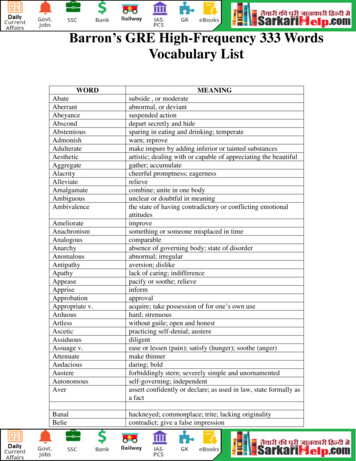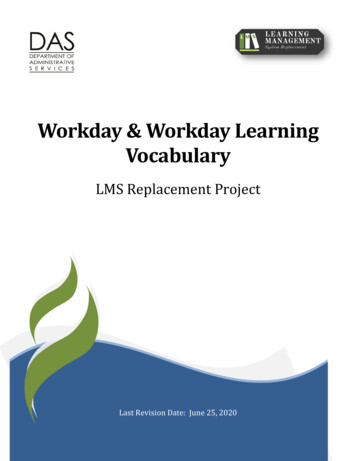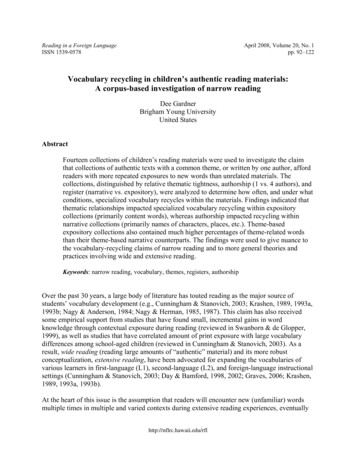
Transcription
Reading in a Foreign LanguageISSN 1539-0578April 2008, Volume 20, No. 1pp. 92–122Vocabulary recycling in children’s authentic reading materials:A corpus-based investigation of narrow readingDee GardnerBrigham Young UniversityUnited StatesAbstractFourteen collections of children’s reading materials were used to investigate the claimthat collections of authentic texts with a common theme, or written by one author, affordreaders with more repeated exposures to new words than unrelated materials. Thecollections, distinguished by relative thematic tightness, authorship (1 vs. 4 authors), andregister (narrative vs. expository), were analyzed to determine how often, and under whatconditions, specialized vocabulary recycles within the materials. Findings indicated thatthematic relationships impacted specialized vocabulary recycling within expositorycollections (primarily content words), whereas authorship impacted recycling withinnarrative collections (primarily names of characters, places, etc.). Theme-basedexpository collections also contained much higher percentages of theme-related wordsthan their theme-based narrative counterparts. The findings were used to give nuance tothe vocabulary-recycling claims of narrow reading and to more general theories andpractices involving wide and extensive reading.Keywords: narrow reading, vocabulary, themes, registers, authorshipOver the past 30 years, a large body of literature has touted reading as the major source ofstudents’ vocabulary development (e.g., Cunningham & Stanovich, 2003; Krashen, 1989, 1993a,1993b; Nagy & Anderson, 1984; Nagy & Herman, 1985, 1987). This claim has also receivedsome empirical support from studies that have found small, incremental gains in wordknowledge through contextual exposure during reading (reviewed in Swanborn & de Glopper,1999), as well as studies that have correlated amount of print exposure with large vocabularydifferences among school-aged children (reviewed in Cunningham & Stanovich, 2003). As aresult, wide reading (reading large amounts of “authentic” material) and its more robustconceptualization, extensive reading, have been advocated for expanding the vocabularies ofvarious learners in first-language (L1), second-language (L2), and foreign-language instructionalsettings (Cunningham & Stanovich, 2003; Day & Bamford, 1998, 2002; Graves, 2006; Krashen,1989, 1993a, 1993b).At the heart of this issue is the assumption that readers will encounter new (unfamiliar) wordsmultiple times in multiple and varied contexts during extensive reading experiences, eventuallyhttp://nflrc.hawaii.edu/rfl
Gardner: Vocabulary recycling in children’s authentic reading materials93resulting in the “incidental acquisition” of those words (Nagy, 1997; Nagy, Anderson, & Herman,1987; Nagy & Herman, 1987; Shu, Anderson, & Zhang, 1995). Proponents have also put forththis hypothesis as being the best explanation of how young L1 learners acquire the bulk of theirlarge vocabularies through the 12th grade, with estimates ranging somewhere between 40,000(Nagy & Herman, 1987) and 80,000 words (Anderson, 1996; Anderson & Nagy, 1992),depending on what is counted as a word.As appealing as this hypothesis has been in reading research and pedagogy, there remains arelative dearth of research studies that have carefully considered the vocabulary input ofchildren’s authentic reading materials to determine how well, and under what conditions, they dorecycle vocabulary, particularly those words that are not from the relatively small pool of highfrequency forms found in most texts (the, of, and, a, take, get, mother, play, etc.). The muchlarger group of more specialized vocabulary items—to which the words of this study belong—constitutes the bulk of the English word stock (Nation, 1990), thus effectively representing thelarge-scale vocabulary (e.g., 40,000 to 80,000 words) that can potentially be acquired during theschool years and beyond.With this background in mind, the aim of the current study is to extend the earlier work ofGardner (2004), in which he analyzed the vocabulary input of a 1.5 million-word extensivereading corpus, consisting of seven children’s narrative collections (four texts each) and sevengrade-equivalent expository collections (four texts each). One of his major findings was that thewords children are exposed to during narrative reading are vastly different than those they areexposed to during expository reading, particularly at the more specialized, content-rich levels ofvocabulary (i.e., beyond the high-frequency words of the language) where 17,921 of 23,857word types (72.5%) were either found in narrative texts only or grade-equivalent expository textsonly (i.e., zero overlap). Additionally, this lack of sharing of critical word types occurred eventhough many of the narrative and expository collections were related by common themes—oneof two conditions proposed by advocates of narrow reading for improving vocabulary recyclingin reading curricula of English as an L2 or a foreign language (e.g., Cho, Ahn, & Krashen, 2005;Day, 1994; Krashen, 1981, 1985, 2004; Schmitt & Carter, 2000), the other being authorship (i.e.,using texts written by the same author). Krashen (1985) has articulated these two conditions asfollows:If the Input Hypothesis is correct . . . it suggests that narrow input is more efficient for L2acquisition, that early specialization rather than late specialization is better, that studentsshould be encouraged to read on only one topic at a time, or several books by the sameauthor, in the intermediate stage, and that [L2] students stay on somewhat familiarground when they first enter the mainstream. . . . In addition, each topic has its ownvocabulary, and to some extent its own style; the same can be said for each author.Narrow input provides many exposures to these new items in a comprehensible contextand built-in review. (p. 73)The current study examines this assertion from the standpoint of authentic vocabulary input fromthe children’s reading corpus (Gardner, 2004), considering theme (topic) and authorship, inaddition to register, as primary variables of interest in order to tease apart nuances of specializedvocabulary recycling in authentic reading collections.Reading in a Foreign Language 20(1)
Gardner: Vocabulary recycling in children’s authentic reading materials94At the outset, the potential benefits of narrow reading are recognized to extend beyondvocabulary recycling only (e.g., exposing L2 readers to consistent stylistic and discourse movesof certain authors). However, because vocabulary recycling is a central tenet of this position, itdeserves more careful examination. A clearer understanding of the impact of text relationshipson vocabulary recycling will serve as a guide for theories and practices in English languageeducation in general, particularly in the areas of wide and extensive reading and vocabularydevelopment. The findings may also prove informative in L1 settings, where the assumedlanguage benefits of theme-based instruction (e.g., Walmsley, 1994) and the known challengeswith content-area, nonfiction reading materials (e.g., Bamford, Kristo, & Lyon, 2002; Vacca &Vacca, 1996) have also received a great deal of attention.Why a Focus on Authentic Reading Materials?Before proceeding, it is important to note that the existence of narrow reading and similarapproaches (e.g., Dubin, 1986) is largely a result of the linguistic characteristics of authenticreading materials. Such materials, unlike graded readers (e.g., Waring, 2003; Wodinsky &Nation, 1988), basal readers (e.g., Bello, Fajet, Shaver, Toombs, & Schumm, 2003), decodabletexts (e.g., Mesmer, 2001), or other linguistically engineered materials, do not intentionallycontrol for the presentation of vocabulary and other language structures. By their nature,authentic reading materials are fairly unpredictable in terms of the language demands they placeon readers, as well as the language-learning opportunities they afford. While authentic oralcommunication is often simplified and repeated in order to achieve the conditions ofcomprehensible input, the same is not true for most authentic written language, which is madepermanent in print, thus removing the author from the reader in terms of both time and space.While modern technology may hold the key to making written text more flexible as a languagelearning tool (Cobb, 2007; Huang & Liou, 2007), and while such technology has also introducede-mailing, on-line chatting, and text-messaging with their real-time, two-way communicationcapabilities, these modes of written communication are vastly different from the linguisticallyfrozen materials of printed school English (novels, trade books, textbooks, etc.). By extension,narrow reading is simply one attempt to deal with this challenge of authentic written input bysuggesting that collections of authentic texts written on similar topics or by one author willimprove the chances that essential linguistic redundancy will actually take place, or in otherwords, that readers, especially L2 readers, will be exposed to necessary levels of repetitive,comprehensible input as they move from one text to the next.Essentially, vocabulary learning from extensive reading is very fragile. If the smallamount of learning of a word is not soon reinforced by another meeting, then thatlearning will be lost. It is thus critically important in an extensive reading program thatlearners have the opportunity to keep meeting words they have met before. (Nation, 1997,p. 15)A clearer understanding of how relationships between authentic reading materials might affectsuch crucial vocabulary recycling is at the heart of the current study.Reading in a Foreign Language 20(1)
Gardner: Vocabulary recycling in children’s authentic reading materials95Why a Focus on Specialized Vocabulary?The work of Paul Nation and his colleagues has been instrumental in showing the distributions ofvocabulary in authentic written and spoken materials. Table 1 is a repurposing of Nation’s (2001)analysis of the distribution of vocabulary in the American Heritage Intermediate (AHI) corpus(Carroll, Davies, & Richman, 1971), which consists of 5 million running words taken from arandom selection of third- through ninth-grade texts. This corpus is particularly important to thecurrent study because it was the primary source for the landmark claims associated with theincidental hypothesis (Nagy & Anderson, 1984) and the call for wide reading in readinginstruction (Nagy, Herman, & Anderson, 1985).Table 1. Vocabulary coverage in the American Heritage Intermediate corpusNumber of word familiesCumulative % of text 087.65,00089.412,4489543,8319986,741100Note. Adapted from Nation (2001, p. 15).Table 1 shows clearly that a small subset of high-frequency word families (i.e., base forms plustheir inflections and transparent derivations, e.g., climb, climbs, climbing, climbed, climber,climbers) covers most of the running words of the AHI corpus. For instance, the top 100 wordfamilies cover nearly half (49%) of the running words, and the top 1,000 word families covernearly three-fourths (74.1%) of the running words. Examples of these high-frequency wordsinclude function words (the, of, and, a, to, in, etc.) and high-frequency content words (take, get,said, people, find, water, words, know, etc.), many of which can be found in authentic children’stexts.However, the remaining 85,741 word families in the AHI corpus (86,741 minus 1,000) coveronly slightly more than one-fourth (25.9%) of the running words. This means that they repeatmuch less frequently in general than the 1,000 high-frequency word families. In most cases,however, these less frequent word families characterize a particular text or content area. They arealso the words that children are less likely to know, and for which the long-term vocabularylearning benefits of extensive reading are most likely to be realized (nourishment, saturated,tomb, mineral, topographic, prohibition, tomahawk, etc.). Determining how often, and underwhat conditions, these words actually repeat in collections of authentic reading materials is thefocus of this study.Reading in a Foreign Language 20(1)
Gardner: Vocabulary recycling in children’s authentic reading materials96Linguistic Studies of Vocabulary Recycling in Narrow-Reading MaterialsMost of the linguistic studies that consider the impact of text-level variables such as theme orauthorship on vocabulary recycling have focused on adult-level materials. The findings arenonetheless important to the current study. For instance, Hwang and Nation (1989) performed ananalysis of the vocabulary load in running stories from newspapers versus the vocabulary load inunrelated stories, concluding that[A] higher proportion of word families outside the 2,000 [most frequent] words will recurin stories from the same series, thus reading running stories reduces the vocabulary loadto a greater extent than reading unrelated stories [and] running stories provide morerepetitions of more words outside the first 2,000 words [italics added] than unrelatedstories, and thus provide more favorable conditions for learning vocabulary [italics added]than unrelated stories. (p. 332)The authors also suggested that their findings have implications for other texts besidesnewspapers, especially in settings of English as a foreign language, where several disparatetopics often comprised textbooks.Sutarsyah, Nation, and Kennedy (1994) also found substantial differences in the distribution ofvocabulary between a single content text (economics), consisting of approximately 300,000words, and a corpus of 160 shorter academic texts (from over 15 subject areas), consisting ofapproximately the same number of words. While the diverse corpus contained a much largervocabulary base than the single text, the words were mostly of lower frequency. In contrast, “asmall number
children’s authentic reading materials to determine how well, and under what conditions, they do recycle vocabulary, particularly those words that are not from the relatively small pool of high-frequency forms found in most texts (the, of, and, a, take, get, mother, play, etc.). The much larger group of more specialized vocabulary items—to which the words of this study belong .
